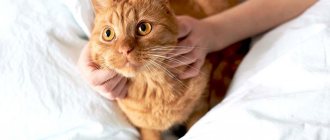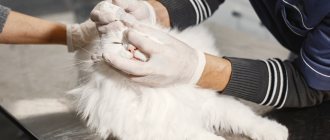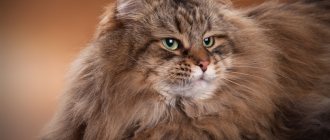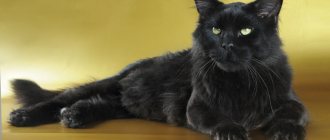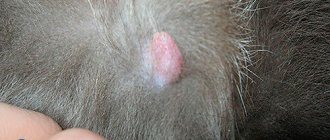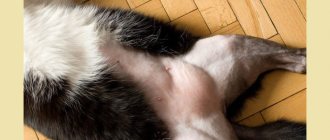Cats have a flexible fold of scruff on the back of their heads, which has a special structure, and doctors use it to treat animals. This withers in a cat is located in the place where the cervical region meets the spine. During illness, doctors inject precisely into this area. It is important for the pet owner to know about it; you need to take the animal by this fold carefully and in special cases.
What is the withers and where is it located?
The withers are located on the back of the animal's head in front of the shoulder blades, which are not difficult to feel with your hand. The body in this area is arched, since the first 5 cervical vertebrae are located under the skin and fat layer. With the help of muscles and tendons, the neck is connected to the body, so this fold is elastic and can be easily separated from the muscle tissue. Thanks to these structural features, namely flexibility, cats perform complex jumps; height is not an obstacle. Despite the fact that the scruff of the neck has a thick layer, there are few nerve endings in it, this is the best place for injections.
Is it possible to give an injection incorrectly?
In this article, we discussed in detail how to correctly inject a cat in the withers subcutaneously. Everything is quite simple, and if you follow the instructions of the doctor and the drug, it is almost impossible to perform the procedure incorrectly.
The main thing is to secure the pet well and choose the right syringe and needle.
If you insert the syringe too deeply, the solution will get into the muscle. It can also leak because you pierced the skin all the way through. If the needle is not inserted deep enough, the injection will be intradermal, which is quite painful and can cause some complications.
Why is it needed?
By nature, the withers have the ability to paralyze the motor activity of the animal when exposed to it. This occurs when receptors inside the fold work; they send impulses to the brain, activating the function of stopping movement. This ability allows the animal to freeze at the right moment, while the pet has the ability to carry offspring without creating noise.
In kittens, there is a section in the cerebellum that is responsible for balance in the air. When they are taken by the scruff of the neck, the brain receives a signal from the cerebellum that it needs to behave calmly and assume a fetal position. Therefore, the cubs are not hurt, they calmly react to such manipulations.
During the training process, in order to convey information to the animal, you need to grab the withers and slightly press the pet to the floor.
The scruff helps owners in matters of raising tailed animals; she is responsible for their behavior. With the correct influence on the fold, it is possible to carry out educational actions on a pet. If the pet does not obey, misbehaves, or shows aggression, the owner must firmly grasp the withers and slightly press the cat to the floor. In this case, it is necessary to quietly but confidently tell the animal that this cannot be done. The main thing to remember is that adult cats should not be lifted by the scruff of the neck; it may hurt them.
Interesting facts about the cat's scruff
One of the most interesting facts about a cat's scruff is that it contains special receptors. When there is interaction between them, the cat automatically relaxes its torso and presses its paws towards it. Such receptors are especially active in cats at a young age, and thanks to this, mother cats calmly carry them by the withers from one place to another. However, it is not advisable for owners of large cats to treat them in this way, since only a cat is capable of carrying kittens by the withers without leaving damage.
Also, the skin on the nape of the neck is quite thick and almost not sensitive due to the minimal number of nerve endings. It is thanks to this that the scruff of the neck is the most convenient and safest place for a cat to carry out subcutaneous injections. When the injection is made taking into account all the rules, the cat will feel practically nothing.
Note! The cat will feel virtually no discomfort or pain if the procedure is performed correctly and in accordance with veterinary standards. That is why most drugs for various diseases and skin parasites are designed specifically for injection under the skin of the neck.
Interestingly, during reproduction, males hold females by the scruff of the neck.
Thus, it was sorted out where the cat’s withers are, what functions it performs for the animal itself, and how the scruff is useful for people. The place is noteworthy in that it is possible to place droppers there or give injections, since it does not contain a large number of nerve fibers, and such procedures are easily tolerated by animals. In addition, a cat's scruff is also useful in nature. The female always carries her cubs in her teeth, and so that they do not hurt and do not move, she has to take them by the withers. It is completely painless, and the animal instantly assumes the fetal position.
Why are medications applied to the withers?
The back of the head is used to treat a pet; it is suitable for subcutaneous injections. Injections into this area are more effective; the drug is absorbed into the blood faster due to the elasticity of the fold. The animal does not experience severe pain during medical procedures. The scruff is used in the fight against fleas and helminths in pets, but it is not available for licking off the medicine. Special anti-parasite drops are placed on the back of the head. There is no need to bathe the kitten after applying the drug; touching or stroking this area is contraindicated - the applied drug can cause poisoning.
Application rules:
- Wear gloves.
- Grasp the withers and spread the fur.
- Apply the medicine to the cartilage protrusion.
- Grind the preparation so that it does not spread.
A cat has sores on its neck and hair is falling out: Where to go?
Saint Petersburg:
- Sotnikov Veterinary Clinic. One of the best clinics in Russia. They deal with both complex cases that require a consultation of doctors, as well as simpler ones. The clinic's doctors are lecturers at conferences aimed at improving the skills of other doctors.
- Vetnet. Specialists will make an accurate diagnosis quickly. Quality treatment will be prescribed.
- Vetus. Top-class veterinary dermatologists work here.
Moscow:
- Medea . A wide range of veterinary services from nail trimming to ultrasound. There is a hospital. Doctors make decisions quickly and efficiently, prescribe only the necessary diagnostics and treatment without frills.
- Clinic Gav. 20% discount on consultations without animals. Friendly staff. Convenient location.
- Your doctor. Renowned dermatologists provide appointments by appointment. It is possible to immediately carry out all diagnostic procedures if the pet is properly prepared. You can always find out more information by phone or on the clinic’s website.
Rostov-on-Don:
- Center. One of the best clinics in Rostov-on-Don. Visitors note the abundance of pet products in the pharmacy. They speak positively about the staff, both administrators and doctors.
- Animal friend. High-class specialists will provide quick and high-quality assistance to your pet if you contact them in a timely manner. There is a flexible system of discounts. Friendly administrators will help and explain everything.
- Veterinary clinic of Dr. Zarubin. The initial appointment is only 200 rubles. Other manipulations are performed according to the price list. The experience of doctors allows us to quickly make an accurate diagnosis and prescribe treatment.
Quantity
Diseases, injuries and treatment
The pet can injure the withers at the time of mating. In such a situation, you need to treat it with brilliant green or peroxide, then trim the hair around the damage and apply a bandage. The fold is a significant area of the body; if it is inflamed, swollen, or red, you should immediately contact a veterinarian. You should not inject antibiotics yourself; only the doctor knows which ones and how hard the syringe is injected under the skin. Next to the scruff is the neck. You can injure the back of the head if you lift or drag the cat by the withers, as children do. Damage to the cervical spine can lead to serious health problems for the animal and even death. It is necessary to take it by the fold carefully.
Symptoms
One of the main signs of lichen is spots without fur.
There are a number of common symptoms for all types of lichen in cats:
- hair loss;
- peeling and inflammation of the skin;
- change in pigmentation;
- inflammation;
- severe itching.
Symptoms of ringworm
With ringworm, a cat loses certain areas of its fur. But the disease begins with a barely noticeable small rash under the fur. Signs that should alert the owner are increased anxiety of the animal and frequent scratching. The development of ringworm in cats is characterized by the following:
- round flaky spots appear on the skin, crusts form;
- the fur in the areas where the rash appears thins, the hairs become brittle;
- smooth, reddened skin is visible under the fallen scales;
- the spots expand and take an oval shape;
- the spread of serous-purulent crusts leads to the formation of scabs;
- the areas of skin underneath are completely missing hair; after recovery, it will not be restored;
- If the cat is not treated, the spots will grow, forming extensive areas of baldness.
The spots are painful, itchy, and cats often chew and scratch them. There is also a form of ringworm in which all the described signs are either absent or clearly not expressed. This clinical picture is called atypical. Only individual hairs of the fur are affected. Ringworm is invisible, therefore, a person does not take any measures until the disease is already advanced.
Ringworm symptoms vary depending on the specific pathogen. In some cases, only the cat's head and face are affected, in others the spots spread to the entire body.
Ringworm in cats
Symptoms of versicolor (pityriasis versicolor)
Tinea versicolor initially looks like a small pale oval spot on the skin of a cat or cat. But after a few days the number of spots increases, they grow together, forming lesions of irregular shape. If the fungus gets into the claw, it becomes deformed.
Interestingly, there is practically no itching with this form of lichen. And when it gets colder, the spots may disappear on their own. The affected surface can be either smooth or scaly. Otherwise, pityriasis versicolor is practically no different from its other types.
Pityriasis versicolor in cats
Symptoms of pink (shingles)
Pityriasis rosea can appear as many small spots like an allergic rash, or it can appear as large pinkish spots up to 2 cm in diameter. Most often, lesions appear on the stomach, inner thighs, and groin of the animal. The itching may be slight or sometimes absent altogether.
In the center the spots are flaky, and at the edges the skin is smooth. In severe cases and without treatment, sepsis may occur if pathogenic microorganisms enter and take root in the lesions. Sometimes pityriasis rosea in a cat is accompanied by fever, joint pain, swollen lymph nodes, and general malaise.
Pityriasis rosea in cats
Symptoms of weeping lichen (wetting eczema)
Ringworm in cats and kittens also begins with red spots. The skin in these areas is hotter than the surrounding area and is also very painful. The rash consists of blisters filled with fluid. When these blisters rupture, their contents are released, causing skin infection and the formation of ulcers and crusts. Sometimes shingles is accompanied by a fever. This type of disease is not dangerous for people.
Lichen planus
